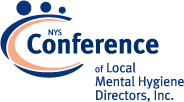NYS Conference of Local Mental Hygiene Directors, Inc. | An Affiliate of the New York State Association of Counties >
Hot Topics / Priority Issues
SAMHSA Medication Assisted Treatment Tools
In July, Health and Human Services (HHS) launched a multi-prong effort to curb opioid use, highlighting the importance of expanding the use of medication assisted treatment (MAT) to treat opioid use disorder.
The SAMHSA-HRSA Center for Integrated Health Solutions (CIHS) offers tools and support to organizations who want to explore how to implement MAT or how they can enhance or expand services for individuals living with substance use disorders. Here are a few key resources to help answer your questions.
Getting started? Learn what steps safety-net provider organizations took to implement MAT from CIHS’ Expanding the Use of Medications to Treat Individuals with Substance Use Disorders. Use the companion Medication Assisted Treatment Implementation Checklist to understand the key questions to consider before engaging in efforts to increase access to MAT. You can also join the National Council for Behavioral Health and the American Academy of Addiction Psychiatry for a three-part webinar series designed to build your functional knowledge of MAT.
Want to explore the evidence? Review the variety of substance use treatment interventions listed on the National Registry of Evidence-Based Programs and Practices that involve MAT. Also, learn more about the health, justice and economic benefits of MAT, along with potential policy recommendations for improving treatment, by reading Confronting an Epidemic: The Case for Eliminating Barriers to Medication Assisted Treatment of Heroin and Opioid Addiction, a report from the Legal Action Center.
Need clinical guidance? SAMHSA publications with clinical guidance on MAT include Treatment Improvement Protocols on Clinical Guidelines for the Use of Buprenorphine and Medication-Assisted Treatment for Opioid Addiction in Opioid Treatment Programs and Medication for the Treatment of Alcohol Use Disorder: A Brief Guide. SAMHSA also funds the Providers’ Clinical Support System for Medication Assisted Treatment to educate and train providers about MAT.
Read additional examples of how organizations adopt MAT in two issues of CIHS’ eSolutions newsletter, including the February 2014 issue that profiles training resources on MAT and the March 2012 issue that profiles how a treatment center in California adopted MAT as part of their care.
Learn what opportunities and restrictions exist for MAT in the ASAM's comprehensive report, Availability Without Accessibility? State Medicaid Coverage and Authorization Requirements for Opioid Dependence Medications.
Want to include MAT as part of Health Home services? Get tips from approved health home models from Maryland, Rhode Island, and Vermont that are tailored to individuals with opioid dependency in Designing Medicaid Health Homes for Individuals with Opioid Dependency: Considerations for States, a brief from the Centers for Medicare & Medicaid Services.
Want even more resources? Keep up with the latest tools and resources on MAT on CIHS’ MAT webpage.



